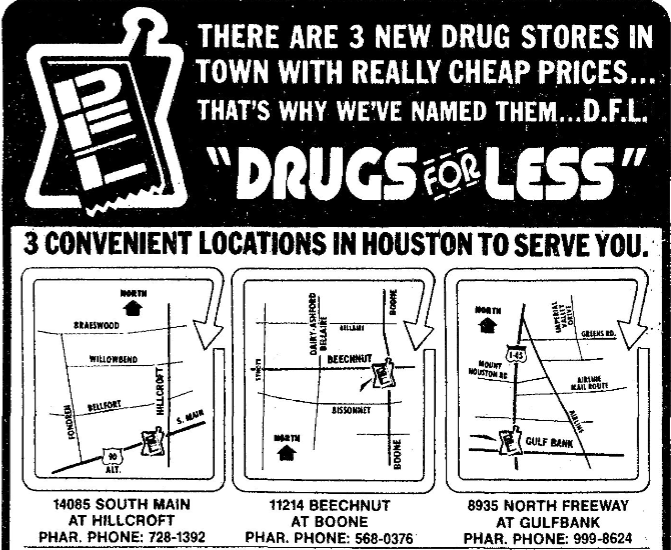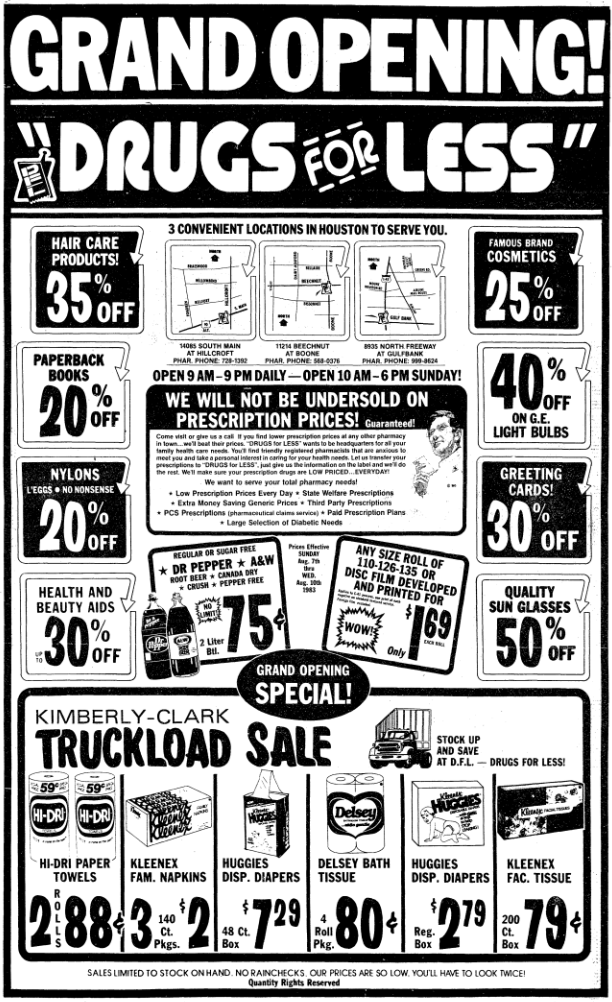Drugs For Less, sometimes known by its initialism DFL, was a discount drug store concept experimented with by Safeway during the 1980s. At its height, DFL had 14 locations in Texas and Oklahoma. The concept of DFL stems from a need to reuse old Safeway buildings after stores had closed. The early 80s was a time of change for Safeway. With the debut of their Super Store concept and ever-increasing competition, Safeway was becoming quite cutthroat with closings. Even by the late 70s, the company had been experimenting with multiple ways to reuse old stores. One concept that showed promise was Food Barn, a no-frills warehouse focusing on rock-bottom pricing by cutting selection to about 3000 items. The first location debuted in Maryland in 1980 and was tried in a few other divisions. On the West Coast, thanks to the legalization of in-store liquor sales, Safeway was experimenting with converting older, smaller stores into full-blown Liquor Stores, initially known as ALPS (Always Low Price Store). The first stores opened in California in the late 70s, and by about 1980, they had received a new name, “Liquor Barn.” Both concepts would perform quite well and allow Safeway to make up lost income from vacant and underperforming stores. However, there were still certain areas where neither concept would fit, and Safeway struggled. Thus, a few other experiments will be conducted. In Utah, where Safeway was quickly failing, they likely had no desire to try discount grocery and felt a liquor store would not perform well, so they instead developed Home Works. This was Safeway’s attempt at entering the exploding DIY Store in the same vein as Builder’s Square or Handy Dan. However, this experiment would be limited to only a handful of locations, never leaving Salt Lake City.
With two successes and a failure on their hands, it seemed apparent at this point that as Safeway expanded, they would try to find creative reuses for their former buildings. Using these spaces to generate income rather than sit dormant could allow Safeway to grow quickly in certain areas. One region targeted for growth was Texas, specifically Safeway’s DFW and Houston divisions. Texas had long been a strong market for Safeway, and a slow expansion in Houston was finally at a point where the oldest stores needed to be replaced. The first talks of reusing buildings began around this time, but an unexpected move by another company would accelerate the program in Texas. In late 1982, Woolworth announced that it would shut down its entire Woolco division. As part of the expansion of Woolco into Texas and Oklahoma, Woolworth had partnered with Safeway to provide grocery stores attached to certain new locations. These stores would close around the same timeframe Woolco did and would sit vacant even though Safeway still had a lease on the property. In April 1983, one of the first mentions of Drugs For Less would be published as a want ad in Oklahoma City for a store attached to a former Woolco. A few months later, a similar ad would be published in Houston for the former Safeway adjacent to Woolco at S. Main and Hillcroft. The ads were interesting as they did not advertise the association of Drugs For Less, and manufacturer ads referred to them as independent. It seems that Safeway was trying to pass this off as a chain separate from the main company, possibly due to the failure of Home Works.
On July 31, 1983, Houston’s first three Drugs For Less locations would open. This would include the aforementioned Woolco adjacent location and two stores that had been replaced by larger locations nearby. The discount drug store was not a new concept to Houstonians, but Safeway wanted to set itself apart from the competition for DFL’s grand opening. They focused on rock-bottom prescription prices in addition to beating the competition on snacks, HBA, and other fare typical of a discount drug store, including developing film. To help maintain their rock-bottom pricing, Drugs For Less stores would carry Scotch Buy products, which was the lowest-tier Safeway store brand. All in all, though, the initial DFL stores were a hit, and Safeway quickly expanded the program to include stores in the DFW, Houston, and Oklahoma divisions. By the end of 1983, Safeway had 11 Drugs For Less Locations under their belt. There were four locations in Oklahoma, four in Houston, two in DFW, and one in Austin. Things were looking promising for Safeway’s newest experiment, and 1984 would bring two new stores to Dallas to bring the total to a “lucky” 13 DFL location. Although beyond late 1984, everything else seemed to come to a stop. Bigger problems began brewing at Safeway, and a “third place” experiment was obviously not a priority.
Safeway had grown massive in the 1980s. It had already become an intercontinental company in the 1960s. When Peter Magowan was made CEO in 1979, he doubled down on the initial visions of his father and grandfather, who had helmed the roles prior all the way back to Safeway’s founding. International expansion would start again for the first time in 20 years, specifically in multiple countries simultaneously. With stores in Mexico, Saudia Arabia, and Australia and a much-needed update of American stores ongoing, the public company was cash-poor and put itself at risk of hostile takeover, a fact the company seems to have become aware of by early 1985 and developed a plan to spin off divisions to quickly generate cash and try to stop a hostile takeover by buying back their own stock at a premium. It seems that in anticipation of this, the expansion of Drugs For Less was all but abandoned. That being said, the chain would be allowed to continue to operate. It was profitable, but with the entire future of Safeway up in the air, the company focused on finishing existing obligations as their worst fears came true. In 1986, Dart Group, a company owned by Herbert Haft, announced they had finally amassed 6% of Safeway and were considering buying the company outright. In a last-minute Hail Mary, Safeway would accept a buyout from another company that promised to keep them alive versus an unsure fate with Dart. Their new owners, KKR, demanded that Safeway make a quick financial turnaround, Liquor Barn would be sold off in 1986, and Drugs For Less would quietly wind down operations. The fourteen stores would all close by the summer of 1986, although a “store within a store” experiment was tried by adding a DFL to a new Safeway in Oklahoma in May 1986. The locations would remain vacant as Safeway prepared for its next moves in Texas, which led to the creation of AppleTree.
Location List
Store No | Address | Notes |
|---|---|---|
| 2502 | 3120 N Buckner Blvd, Dallas, TX 75228 | 1983-1986, Safeway 72-80, Still standing as of 2024 |
| 2503 | 410 E Camp Wisdom Rd, Duncanville, TX 75116 | 1983-1986, Safeway 64-83, Heavily modified, 99 Cents Only Store as of 2024 |
| 2509 | 14085 S Main St, Houston, TX 77085 | 1983-1986, Safeway 70-83, Adjacent to a Woolco, Still standing as of 2024 |
| 2510 | 8935 North Fwy, Houston, TX 77037 | 1983-1986, Safeway 71-83, Demolished 2006 for HD Supply |
| 2511 | 11214 Beechnut St, Houston, TX 77072 | 1983-1986, Safeway 74-82, Still standing, El Ahorro as of 2024 |
| 2512 | 11600 Hughes Rd, Houston, TX 77089 | 1983-1986, Safeway 71-83, Still standing, Sagemont Church as of 2024 |
| 2513 | 8666 Spicewood Springs Rd, Austin, TX 78759 | 1983-1986, Safeway 75-83, Still standing, Big Lots as of 2024 |
| 2515 | 2450 Jupiter Rd, Plano, TX 75074 | 1984-1986, Safeway 73-84, Still standing, Plano ISD Jupiter Center as of 2024 |
| 2516 | 10720 Preston Rd Ste 1018, Dallas, TX 75230 | 1984-1986, Safeway 65-84, Still standing, Central Market as of 2024 |
| 2520 | 908 E Pioneer Pkwy, Arlington, TX 76010 | 1986, Safeway 70-86, Still standing, 99 Cents Only Store as of 2024 |
| ? | 6022 S Western Ave, Oklahoma City, OK 73139 | 1983-1986, Address Aproximate |
| ? | 7300 S Shields Blvd, Oklahoma City, OK 73149 | 1983-1986, Adjacent to a Woolco, Still standing as of 2024 |
| ? | 1645 SW 47th St, Oklahoma City, OK 73119 | 1983-1986, Former Safeway? |
| ? | 9300 N Pennsylvania Ave, The Village, OK 73120 | 1983-1986, Demolished 2003 for Walmart Neighborhood Market |



